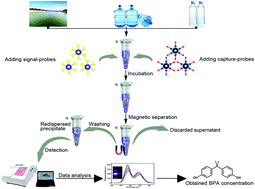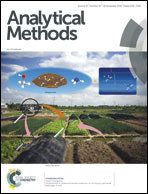Sensitive detection of bisphenol A in drinking water and river water using an upconversion nanoparticles-based fluorescence immunoassay in combination with magnetic separation†
Abstract
We have proposed a sensitive fluorescence immunoassay for detecting bisphenol A (BPA) in barreled drinking water, bottled mineral water, and river water using the anti-BPA antibody conjugated carboxyl-functionalized NaYF4:Yb/Tm upconversion nanoparticles (UCNPs) (emission maximum at 454 nm with excitation at 980 nm) as the signal probe and the coating antigen conjugated carboxyl-functionalized magnetic polystyrene microspheres (MPMs) as the capture probe. The proposed assay has a linear detection range of 0.1 to 500 μg L−1 (R2 = 0.9954). The water samples without any pretreatment can be directly analyzed. The limit of detection (LOD) of BPA in the water samples is 0.02 μg L−1. The recoveries of BPA from spiked water samples for the proposed assay range from 85.35% to 108.35%. Low concentrations of BPA have been detected in the real barreled drinking water and river water samples, and the results are validated by high-performance liquid chromatography (HPLC) to be reliable, reflecting the good practicability of the proposed assay. The proposed fluorescence immunoassay can serve as a useful detection approach for the simple, rapid, sensitive, and accurate determination of BPA in drinking and environmental water.



 Please wait while we load your content...
Please wait while we load your content...